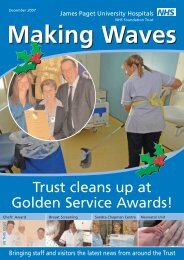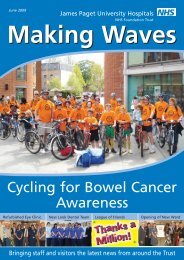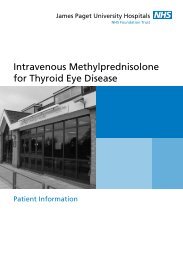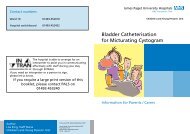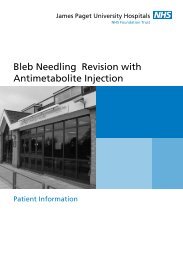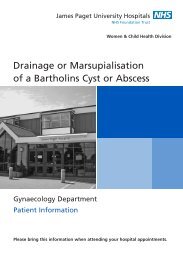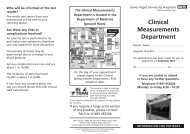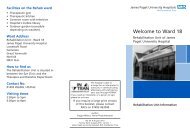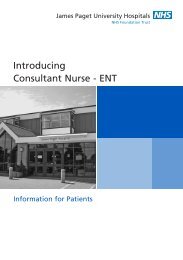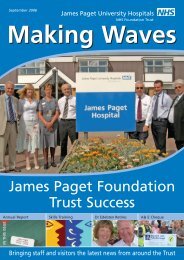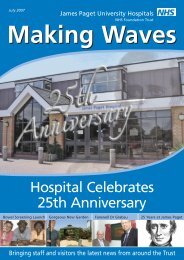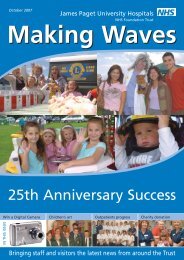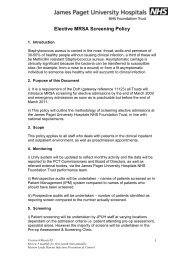Where you come first Where you come first - James Paget University ...
Where you come first Where you come first - James Paget University ...
Where you come first Where you come first - James Paget University ...
Create successful ePaper yourself
Turn your PDF publications into a flip-book with our unique Google optimized e-Paper software.
CQC<br />
Reflections by John Hemming<br />
I became Chairman of the Trust in November 2003, succeeding the much respected John Wells, who had been Chairman for<br />
ten years.<br />
For the previous two years I had been a Non Executive<br />
Director on the Board. One of the things that struck me<br />
about the local NHS was that its planning was very short<br />
term and reactive and I felt that we should plan over a<br />
wider time horizon, so we could plan investments and<br />
developments to improve patient experiences and maximise<br />
the benefits from those investments.<br />
I did not realise then quite how frequently the NHS was<br />
reorganised. I have since found out that the NHS has had<br />
three ‘once in a lifetime’ reorganisations in the last fifteen<br />
years.<br />
The Trust decided to produce a Ten Year Plan in 2003/04,<br />
based on the NHS Ten Year Plan of 2001, with the objective<br />
of ‘Delivering the NHS Plan vision of a high quality, effective<br />
and responsive service to its local population.’ We repeated<br />
this exercise the following year, but have now integrated<br />
it into our Strategic Plan (updated annually) and the Three<br />
Year Business Plan, which is produced every May.<br />
Headlines from the 2003 version included:<br />
• Waiting times would halve between 2004 and 2010<br />
• Staff levels would increase<br />
Of the Trust’s estate, 30% required refurbishment within<br />
5 years, 30% in the next 5 years and 40% was fit for the next<br />
10 years.<br />
Investment in training would be essential to helping the<br />
Trust meet patient, public and staff expectations in quality of<br />
care, working lives and patient and public involvement.<br />
Capital funding was difficult in the existing regime, FT<br />
status would improve our ability to obtain and use capital.<br />
Some of the proposals included:<br />
• New Education and Training Centre<br />
• New ICU and later extensions to ICU/HDU<br />
• Pain Clinic Palliative Care Orthopaedics, Opthalmology,<br />
Pre-Operative assessment area, Dental and Audiology<br />
required urgent provision/improvement<br />
• Extended Renal unit (consumed Board Room, Swords into<br />
ploughshares event)<br />
• 9 inpatient wards were in need of major upgrades<br />
• IT would double in five years using the mandated<br />
national programmes<br />
Looking back we have achieved virtually all of these.<br />
The national IT programme did not materialise in the<br />
expected manner and we have developed our own<br />
systems.<br />
We have continued our programme of Ward<br />
improvements. One of the main drivers has been the<br />
desire to improve patient privacy and dignity, by moving<br />
wherever possible to replace six bedded bays with four<br />
bedded bays. Such areas also help improve the reduction of<br />
Health Care Acquired Infection (HCAIs) with greater space<br />
between beds and easier cleaning.<br />
Some of my personal highlights are:<br />
ICU opening with the Princess Royal just before I became<br />
Chair, Education and Training Centre, Pain Clinic, EADU,<br />
Breast unit, extended Renal unit in old Boardroom, award<br />
of Cleanest Hospital in England, revised Children’s ward,<br />
(where seven children all individually cut the ribbon) new<br />
Radiology waiting area improving patient privacy and<br />
dignity, Ward 16, our latest state of the art ward, and<br />
the new Stroke Ward, which moves our stroke care forward<br />
significantly.<br />
<strong>University</strong> Hospital Status<br />
The Trust was a founder member of the Board of the UEA<br />
School of Medicine and as such played a major part in<br />
establishing the school. There were originally 120 students<br />
per year, now 170, to be trained.It was initially planned that<br />
10% of the teaching should be done at the JPUH. Such was<br />
the enthusiasm and commitment of the Consultant body<br />
here and the quality of training, reflected in the student<br />
feedback, that the Trust now provides about 30% of the UEA<br />
training. A benefit of this is funding for 12 extra Consultants,<br />
effectively back filling the teaching time, a great addition<br />
to our core competencies. It makes us more attractive to<br />
staff as a place to work, keeps us at the forefront of clinical<br />
knowledge and thereby helps us provide better patient care.<br />
The building of the Education and Training Centre, opened<br />
2005, supports the activity.<br />
Foundation Trust Status<br />
The Trust, together with all its stakeholders, decided<br />
that it wished to be<strong>come</strong> a Foundation Trust (FT) in 2003,<br />
and set about the process. As an FT we would have new<br />
accountabilities – operate to national healthcare standards<br />
and targets, and not be performance managed by the<br />
SHA. The Board of Directors would take responsibility for<br />
governance of the Trust and we would be regulated by<br />
Monitor who would initially ensure that we were legally<br />
constituted, financially viable and sustainable and well<br />
managed.<br />
It took us three years to achieve FT status after consulting<br />
widely with stakeholders and the general public, presenting<br />
how we would organise ourselves and how local people<br />
could have more influence on what we do. We recruited<br />
members from the local population (9,500), established<br />
the Governors Council, with elections for the majority of<br />
Governors (Public now 20 and Staff 7) and eight appointed<br />
Governors from some of our key Stakeholders, (Norfolk<br />
and Suffolk County Councils, Great Yarmouth Borough<br />
Council and Waveney District Council, UEA and PCT and<br />
Volunteers) which started to meet in Shadow form<br />
in April 2006. We developed our Governance<br />
structures and the Board undertook an in<br />
depth assessment of our finances and our<br />
strengths and weaknesses.<br />
We were delighted to gain FT<br />
status on 1 August 2006, the <strong>first</strong><br />
Trust in Norfolk and Suffolk to do<br />
so. Some of the benefits are that we<br />
have closer involvement with our local<br />
community, which is critical for the<br />
future given increasing demands<br />
and reducing resources for the<br />
acute sector. We retain our<br />
surpluses (c.£12m<br />
since 2006) and<br />
can use them<br />
to reinvest<br />
in facilities<br />
and services<br />
to improve<br />
patient<br />
care.<br />
Page 8 Making Waves Newsletter December 2011 www.jpaget.nhs.uk



